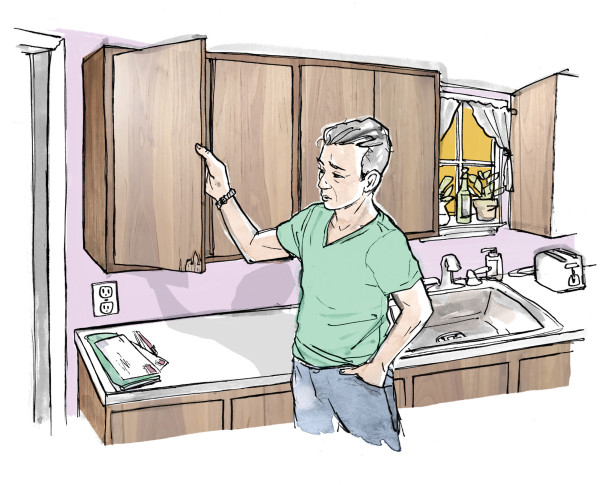
In some small areas, the veneer has lifted away, chipped, or splintered.
Illustration: Brett Affrunti
“We recently bought a 1960s Mid-century Modern with original walnut-veneer cabinets. I’ve always thought veneer signaled ‘cheap’, but these MCM-period cabinets look well designed and crafted. In some small areas, the veneer has lifted away, chipped, or splintered. I suppose we will resign ourselves to replacing them, when we have the money.” —Thomas Petty
The Fix
Thinking “veneered” means “cheap” is a common misconception. Historically speaking, however, veneers as thin as 1/32″ were used on some of the choicest furniture and cabinetwork, in styles from Neoclassical to Art Deco. Since your cabinets are faced in book-matched walnut, you likely have a mid-century treasure worthy of restoration.
Light damage may be a relatively easy, DIY repair. For veneer that has lifted away from the edge of the door, for example, insert the end of an emery board or a paper clip into the crack and scrape out as much deteriorated glue as possible. Using a flattened plastic straw, blow any powdery glue dust out of the crack. Then spread a small amount of wood glue into the crack using a glue-filled syringe (available at craft and hardware stores). Press down on the veneer and release several times to make sure the glue spreads thoroughly. Wipe away any excess with a damp cloth. Clamp the area, first protecting it with plastic wrap and small scraps of wood to prevent the clamps from damaging the veneer, and allow it to set.
For minor chips or splinters, choose a replacement veneer that closely matches your cabinets in grain, color, and pattern; do your selection in person at a craft store. For the repair, neatly cut out the damaged area using a straightedge and a sharp utility knife. Straight lines will make the repair less visible. Cut only deep enough to remove the veneer, not the substrate below it.
Match the grain on the new veneer to the old before cutting the patch. If the new veneer is thinner than the old, glue down a piece of kraft paper to make the repair level. Apply a thin layer of wood glue to the substrate and a similar amount to the new veneer. Then press the patch into place. Use the same protective clamping procedure recommended above.







